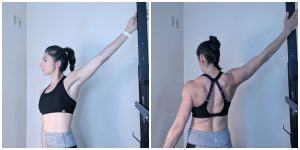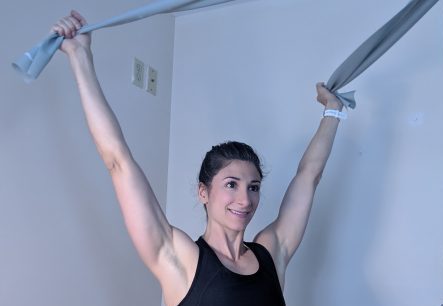
The last piece of relevant corrective exercises to improve shoulder mobility for pull-up progressions is focused on glenohumeral internal and external rotation. Once you have determined what your client’s shoulder joint limitations are from the last blog on how to assess shoulder mobility restrictions you can begin improving mobility by lengthening and strengthening the correct muscles. If you have found that your client has overactive internal rotators and short external rotators, then its time to apply the optimal programming to correct the imbalance. The following exercises correspond with each muscle action that needs to be addressed.
Release and Lengthen Internal Rotators: Pectoralis, Subscapularis, and Teres Major
We know that the pectoralis major is the primary synergist for horizontal abduction, but it also internally rotates the humerus, especially when the arms are alongside the torso. The subscapularis is an internal rotator cuff muscle that lies along the anterior surface of the scapula. The teres major is a synergist of the latissimus dorsi, assisting in internal rotation and attaches from the inferior border of the scapula to the humerus. (Friendly anatomy reminder: Yes, the lats are also internal rotators. Be sure you have addressed this limitation with the corresponding lat corrective exercises)
Targeting these smaller muscles is difficult with the following technique, but some relief may be noted. While a foam roller lacks specificity it is more forgiving than searching for trigger points with a ball or fingers.
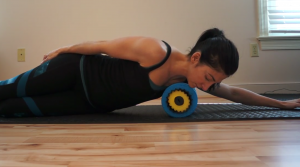
- Lie on your side on the ground with arm overhead and foam roller under shoulder joint above armpit.
- Turn palm up to externally rotate the shoulder.
- Roll slightly forward and search for tenderness in the subscapularis. Hold each tender spot for 30-120 seconds.
- Roll even more forward onto anterior surface of upper rib cage to hit the pec major.
- Roll slightly distal to the starting point (downward towards ribs) to hit the teres major.
Statically Stretch Pecs
- Stand with one arm abducted and extended overhead about 60 degrees, with palm up and hand placed on a wall or solid surface.
- Actively retract both scapulae and lean forward to prevent scapular tipping.
- Rotate away from the wall to stretch pecs.
- Hold for at least 30 seconds and then repeat on the other side.
Strengthen External Rotaters
Strengthening external rotation in multiple planes is important for overall balance to this muscle group. It is important to move slowly and concentrate on the muscles that are operating.
Banded external rotation (horizontal plane)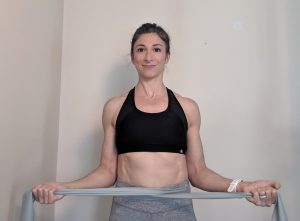
- Place a long, light resistance band behind the lower back and criss-cross the ends to the front of the body, taking the ends in either hand. (alternatively, you can hold a shorter band in a line in front of you)
- While keeping both shoulders slightly flexed (slightly in front of you), fully adducted and in contact with the ribcage, pull against the resistant into external rotation and hold for 3 seconds.
- Slowly return to start position and perform two sets of 12-15 reps.
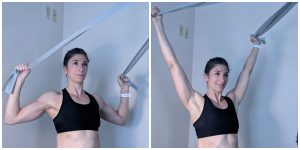
Banded WY pulls
- Anchor a long, light resistance bad at eye level and hold the ends with either hand.
- Pull the arms back into a “W” position with arms and back firmly in frontal plane and hold for one second.
- From the “W” position, extend the elbows so the arms are in a “Y” position while keeping shoulders depressed and hold for one second.
- Return to the start position by keeping the elbows straight and allow scapulae to protract without rolling forward (flexing) through the thoracic spine.
- Perform two sets of 12-15 reps.
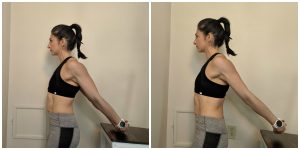 End Range Shoulder Extension Strengthening
End Range Shoulder Extension Strengthening
Training the humerus to remain externally rotated through shoulder extension will assist not only in the concentric phase of a pull-up, but it will help maintain proper form through dips, rows and tricep kickbacks.
- Kneel on the floor in front of a bench.
- Extend both arms behind the torso and interlace fingers, palms facing each other and rest knuckles on surface before a stretch in anterior deltoid is felt.
- The scapulae should remain fixed and firm against the rib cage and shoulders should not roll forward.
- From this position, lift the hands off of the bench and hold for five seconds.
- Return to start and perform 3 sets of 10 reps.
- Advance to hands unlocked, palms down and arms parallel.
*If flexibility is very limited preventing hands to come together at all, work on this same movement standing up using something like an Olympic bar set to a height that can be grabbed by both hands behind the back. The effort in this case will be to bring the hands closer together until arms are parallel, then the above exercise can be attempted.
Next Step
After spending about 2 to 3 weeks on this corrective programming, perform the initial assessments and observe if improvements have been made. Acknowledge that perfect mobility may be difficult to achieve, but you want to get as close to your client’s full potential as possible.
Observe your client performing lat pull-downs employing a full, Active ROM before progressing to pull-ups or chin-ups. If in your professional estimation your client is ready to move on, then go for it!

